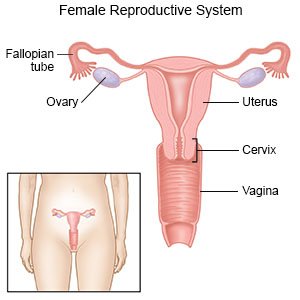Endometrial Polyps
Medically reviewed by Drugs.com. Last updated on Apr 6, 2025.
What is an endometrial polyp?
A polyp is a mass of tissue that grows in the lining of your uterus (called the endometrium). A polyp is connected to the lining by a stalk. A polyp may be cancer, but most polyps are benign (not cancer). The size can range from very small to about the size of a golf ball. A large polyp may push down through the cervix and into your vagina. You may also have more than one polyp.
 |
What increases my risk for an endometrial polyp?
- High estrogen (female hormone) levels
- Obesity
- Age 50 years or older
- Use of certain breast cancer medicines
What are the signs and symptoms of an endometrial polyp?
You may have no signs or symptoms. The polyp may be found during tests or treatment for another condition. You may have any of the following if you do have signs or symptoms:
- Irregular bleeding during childbearing years, or trouble getting pregnant
- Heavy bleeding during your period
- Spotting, especially after sex
- Vaginal bleeding after menopause
How is an endometrial polyp diagnosed?
Your healthcare provider will examine you and ask about your symptoms. Certain tests may be used to check for a polyp. During a sonohysterogram (water ultrasound), water is pushed into your uterus to keep it expanded. This helps the ultrasound see polyps more easily. A hysteroscopy is a test that uses a scope to see inside your uterus. Tissue samples may also be taken and sent to a lab to be tested for cancer.
How is an endometrial polyp treated?
An endometrial polyp may go away on its own without treatment. If it does not go away, causes discomfort, or gets larger, it may need to be removed. A procedure called a dilation and curettage (D&C) is usually used to remove endometrial polyps. During a D&C, your healthcare provider will remove tissue from your uterus. This will remove the polyp along with the other tissue. You may need more than 1 D&C if the polyp is not removed the first time. A hysterectomy may be used to remove your uterus if you have several polyps that are cancer.
What can I do to manage an endometrial polyp?
- Reach or maintain a healthy weight. Extra weight increases your estrogen level. This can increase your risk for more polyps. Talk to your healthcare provider about a healthy weight for you. He or she can help you create a weight loss plan if you need to lose weight.
- Eat a variety of healthy foods. Healthy foods can help you manage your weight and lower your risk for cancer. Healthy foods include fruits, vegetables, low-fat dairy products, cooked beans, lean meats, and fish. Your healthcare provider or a dietitian can help you create a healthy meal plan.

- Talk to your healthcare provider about pregnancy. You may have problems getting pregnant if the polyp affects other parts of your reproductive system. Your healthcare provider can talk to you about treatment that may help.
When should I seek immediate care?
- You have bleeding from your vagina that continues or is bright red.
- You feel dizzy or lightheaded from heavy blood loss.
When should I contact my healthcare provider?
- You have new or worsening symptoms.
- You have symptoms again after successful treatment for a polyp.
- You have questions or concerns about your condition or care.
Care Agreement
You have the right to help plan your care. Learn about your health condition and how it may be treated. Discuss treatment options with your healthcare providers to decide what care you want to receive. You always have the right to refuse treatment. The above information is an educational aid only. It is not intended as medical advice for individual conditions or treatments. Talk to your doctor, nurse or pharmacist before following any medical regimen to see if it is safe and effective for you.© Copyright Merative 2025 Information is for End User's use only and may not be sold, redistributed or otherwise used for commercial purposes.
Further information
Always consult your healthcare provider to ensure the information displayed on this page applies to your personal circumstances.
